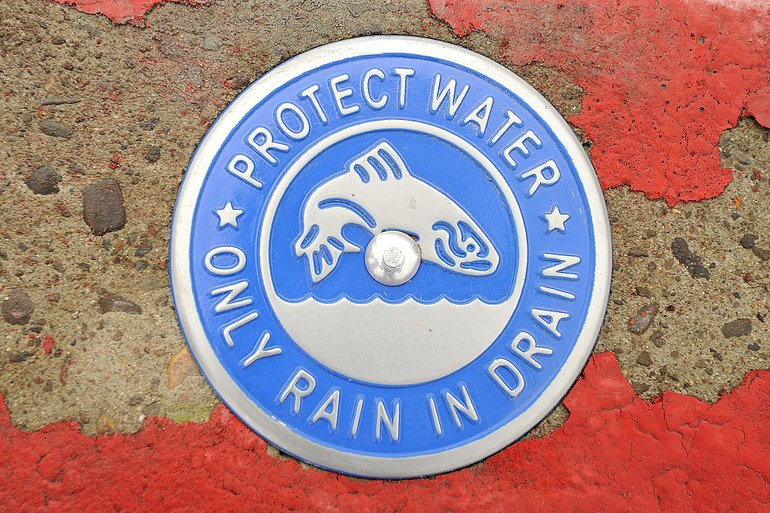They’ve seen the common culprits: paint, oil, bottles and cans. They’ve seen the unusual: RV septic tank waste, dead rodents and cat litter, among other untold treasures.
Whatever ends up in a Clark County storm drain ends up in a stream or waterway. County officials are turning to a new approach to change that, installing four-inch medallions above thousands of storm drains to make people think twice before dumping.
The silver-and-blue medallions read “Protect Water — Only Rain In Drain” around the image of a fish. They’ll be installed in addition to the painted message already on many drains.
“Hopefully, the reminder will be more constant,” said Cary Armstrong, a waste reduction specialist in the county’s Environmental Services Department. “It reinforces what we’re trying to teach.”
That message is simple — don’t put anything in a storm drain but water.
The county bought 5,000 medallions using grant money from the Washington State Department of Ecology. It will give 1,800 of those to four cities in the Stormwater Partners of Southwest Washington consortium, according to Cindy Stienbarger, a county environmental services outreach manager. Two cities in the group — Washougal and Camas — received extra medallions of a different design they had already installed.
For Clark County, that job falls to Duane Marchand, a maintenance technician who has spent the past few weeks installing the medallions single-handedly, mostly on storm drains at local schools.
Marchand entered Thursday with 497 installations under his belt since mid-June. He arrived at Columbia River High School early in the morning with his main tool: an 80-pound core drill that cuts a circular outline into concrete or asphalt, where the medallion is set.
“Me and this tool are getting to be good friends,” Marchand said.
Marchand knocked out his first installation of the day routinely, then moved to a second drain in the school parking lot.
He started by setting plywood over the drain, then carefully lining up the drill to reach the curb above it. Marchand began cutting a four-inch circle, spraying water to keep the drill from getting too hot. He used a makeshift pressure washer to clear dirt and debris from the hole — away from the drain, of course.
Marchand placed a medallion snugly in the outline, then pounded a rivet in the center to secure it.
In eight minutes, the job was done — number 499. He smiled.
“OK,” he said. “There it is.”
Marchand expected to push his total past 530 by the end of the day. He’s averaging around 38-45 installations daily, he said.
Many residents don’t realize that Clark County’s stormwater system functions differently than on the other side of the Columbia River, Armstrong said. In Portland, both sewer and stormwater pipes route through treatment plants before returning to waterways, he said. Here, only sewer pipes do.
“A lot of people, they don’t make the connection that what goes down a drain ends up in a stream eventually,” Stienbarger said. The county would like to place medallions on as many of the 11,000 publicly maintained storm drains in unincorporated areas as possible, depending on funding.
Columbia River High School offered a fitting backdrop. Just east of where Marchand worked, Cougar Creek meanders below the parking lot.
“From here,” Stienbarger said, “it’s not a very long trip.”
Eric Florip: 360-735-4541 or eric.florip@columbian.com.




